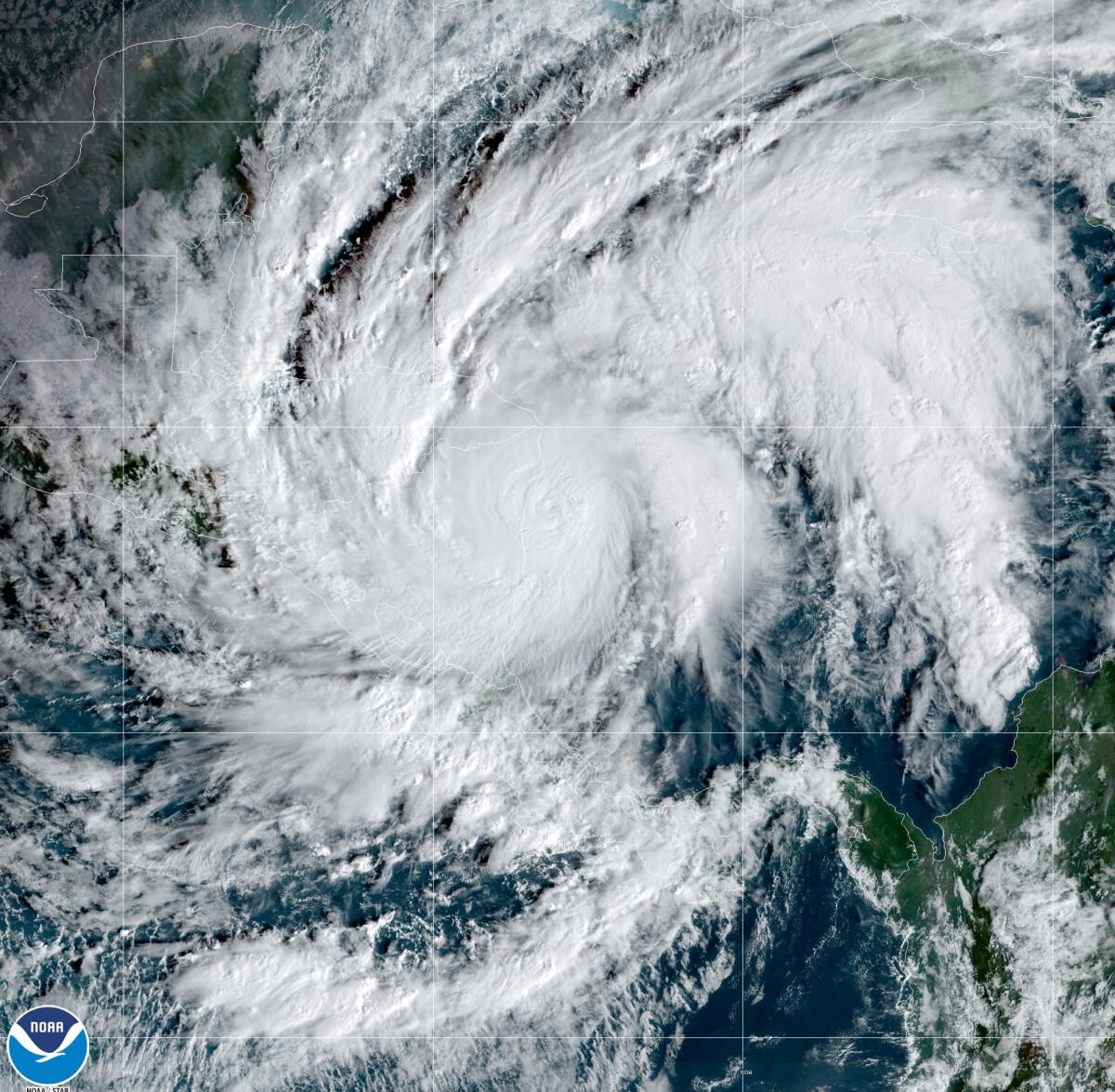Hurricane Eta slams into Nicaragua as a Category 4 storm

- Share via
MANAGUA, Nicaragua — The heart of powerful Hurricane Eta began moving ashore in Nicaragua on Tuesday with devastating winds and rains that had already destroyed rooftops and caused rivers to overflow.
The hurricane had sustained winds of 140 mph, according to the U.S. National Hurricane Center, down from an overnight peak of 150 mph.
While the eyewall of the Category 4 hurricane had hit shore, its center was about 20 miles south-southeast of coastal Puerto Cabezas and was moving west near 3 mph.
Landfall came hours after it had been expected. Eta’s eye had hovered just offshore through the night and Tuesday morning. The unceasing winds uprooted trees and ripped roofs apart, scattering corrugated metal through the streets of Bilwi, the main coastal city in an otherwise remote and sparsely populated area. The city’s regional hospital abandoned its building, moving patients to a local technical school campus.
“It was an intense night for everyone in Bilwi, Waspam and the communities along the northern coast,” Yamil Zapata, local Bilwi representative of the ruling Sandinista Front, told local Channel 4 on Tuesday.
Guillermo González, director of the country’s emergency management agency, said in a news conference earlier that there were reports of corrugated metal roofs flying off homes, trees, poles and power lines falling and rivers rising in the coastal area. So far, there were no reported injuries or deaths, he said.
About 10,000 people were in shelters in Bilwi and an equal number in smaller towns across the region, he said. The area had already been lashed with strong winds and heavy rain for hours.
Authorities in Nicaragua and Honduras had moved people Monday from outer islands and low-lying areas to shelters. Residents scrambled to shore up their homes, but few structures along Nicaragua’s remote Caribbean coast were built to withstand such force.
Nicaragua’s army moved red-helmeted troops specialized in search and rescue to Bilwi.
At a shelter in Bilwi, farmer Pedro Down waited late Monday for Eta’s arrival. “When it comes it can rip off all the [roof] and destroy the house, so you have to look for a safer place,” he said, cradling a baby in his arms. “So I came here to save our lives.”
Nicaragua Vice President and First Lady Rosario Murillo appeared on television Monday and prayed for God to protect the country. She said Nicaragua would apply lessons learned from previous storms. “How many hurricanes have come and we have moved on, thanks to God,” she said.
Along Honduras’ northern Caribbean coast, torrential rains from Eta’s outer bands caused some rivers to overwhelm their banks Monday, forcing evacuations.
This could be only the beginning of Eta’s destruction. The storm was forecast to spend much of the week meandering over Central America.
Forecasters said central and northern Nicaragua and much of Honduras could get 15 to 25 inches of rain, with 35 inches in isolated areas. Heavy rains also were likely in eastern Guatemala, southern Belize and Jamaica.
A storm surge of around 15 feet above normal tides was possible for the coast of Nicaragua, forecasters said.
The quantities of rain expected drew comparisons to 1998’s Hurricane Mitch, one of the most deadly Atlantic hurricanes in history. An archival report from the National Hurricane Center said Mitch led to the deaths of more than 9,000 people.
Eta tripled in strength in about 24 hours, rapidly intensifying from a 40 mph storm Sunday morning to a 120 mph hurricane around midday Monday, and continuing to gain power throughout the day.
It is the eighth Atlantic storm this season to hit the meteorologists’ definition for rapid intensification — a gain of 35 mph in wind speed in just 24 hours. It’s also the fifth to reach major hurricane status. Over the last couple of decades, meteorologists have been increasingly worried about storms that just blow up in strength.
Eta is the 28th named Atlantic storm this season, tying the 2005 record for named storms. It’s the first time the Greek letter Eta has been used as a storm name because after the 2005 season ended, meteorologists went back and determined a storm that should have been named wasn’t.
Hurricane season still has a month to go, ending Nov. 30. In 2005, Zeta formed toward the end of December.
More to Read
Sign up for Essential California
The most important California stories and recommendations in your inbox every morning.
You may occasionally receive promotional content from the Los Angeles Times.










